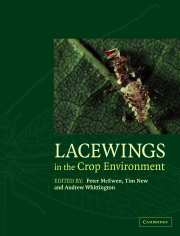Book contents
- Frontmatter
- Contents
- List of contributors
- Preface
- PART 1 Lacewing systematics and ecology
- PART 2 Lacewings in crops
- Introduction to Part 2
- CHAPTER 8 Lacewings in field crops
- CHAPTER 9 Lacewings in fruit and nut crops
- CHAPTER 10 Lacewings in vegetables, forests, and other crops
- PART 3 Principles
- PART 4 Case studies
- PART 5 Conclusion
- Taxonomic index
- General index
CHAPTER 9 - Lacewings in fruit and nut crops
Published online by Cambridge University Press: 04 May 2010
- Frontmatter
- Contents
- List of contributors
- Preface
- PART 1 Lacewing systematics and ecology
- PART 2 Lacewings in crops
- Introduction to Part 2
- CHAPTER 8 Lacewings in field crops
- CHAPTER 9 Lacewings in fruit and nut crops
- CHAPTER 10 Lacewings in vegetables, forests, and other crops
- PART 3 Principles
- PART 4 Case studies
- PART 5 Conclusion
- Taxonomic index
- General index
Summary
APPLE
Apple (Malus pumila) is one of the most widely cultivated fruit-tree species. Different species from the Malus genus, such as Malus sylvestris (Europe), and M. baccata and M. prunifolia (southeast Asia, Japan, China) are endemic throughout Eurasia. Malus pumila has the greatest economic significance, and it is grown as a great number of cultivars all over the world from smaller house gardens to intensively managed largesized commercial orchards mainly under temperate and Mediterranean climatic conditions.
Characteristics of lacewing assemblages in apple orchards
In apple orchards, species-rich arthropod communities can be built up consisting of hundreds of species (Szentkirályi & Kozár, 1991). Reviewing the published insect communities of apple orchards of the world, Szentkirályi & Kozár (1991) found that from total species-richness values, Neuropteroidea assemblages shared between only 0.6 and 5.1%. Homoptera, serving as the major potential prey source, ranged between 0.2% and 20.5%, meaning more than 100 species in certain cases. Due to its economic importance, apple is one of the cultivated plants, which has been very well studied regarding its pests. Thanks to numerous field investigations, a relatively high number of publications contain data on the natural enemies of apple pests. In the case of chrysopids and hemerobiids, most studies are from Europe and North America but some are from Asia, Australia, and New Zealand. Table 9.1 summarises lacewing records of European apple orchards, while all the others are shown on Table 9.2.
In European apple orchards (Table 9.1), a total of 15 green and 26 brown lacewing species have been detected.
- Type
- Chapter
- Information
- Lacewings in the Crop Environment , pp. 172 - 238Publisher: Cambridge University PressPrint publication year: 2001
- 19
- Cited by



